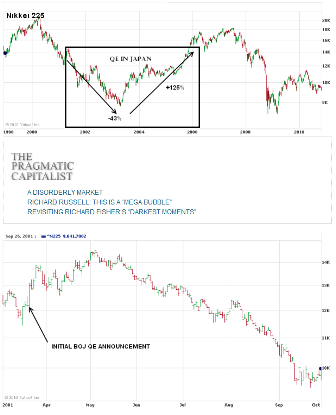>
> (email exchange)
>
> On Thu, Nov 4, 2010 at 11:26 PM, wrote:
>
> Do you have any thoughts on this supposed wealth effect?
>
There is one but I see it as coming from deficit spending, and probably not QE.
Federal deficits support income and add to net financial assets,
which is the financial equity and income that supports the credit structure.
The question is whether QE net adds to nominal wealth via the equity price channel, via ‘valuation’ due to lower long term risk free rates/higher pe’s.
First, the evidence isn’t clear that QE results in higher equity prices, with Japan as the leading example.
Second, there’s the question of whether the maybe 75 billion of annual income- about 1/2% of gdp removed from the private sector- is a stronger force than the valuation benefits of the lower discount rates.
Third, let me suggest that by doing QE on a quantity basis rather than targeting a rate, the change in rates on a ‘bang for the buck’ basis could be a lot lower than if the rate was directly targeted.
Let me give a possible example. Let’s say the Fed simply targeted the 10 year tsy at 2.25%. They would have a bid at that level and buy all the secs the market didn’t want to buy at that level. They may in fact buy a lot or a very few, and possibly none at all, depending on tsy issuance, investor demand, and market expectations. But let’s say for this example they did that and bought a total of $1 T 10 year notes defending the 2.25% level.
Now let’s say that instead, the FOMC had limited the Fed to buying $900 billion. The question then is how high would 10 year notes trade with that $100 billion free to trade at market levels?
What I’m saying is it could be at much higher yields, as the market expectation component of demand does its thing. The yield would simply be the same as if the Tsy had issued $900 billion fewer 10 year notes.
Note that we went for years with no issuance of 30 year t bonds, and 30 years t bond rates on the outstanding bonds did not fall to 0.
Yes, the curve flattened maybe 50 basis points, and steepened again when issuance resumed, but in the scheme of things it was a factor for the macro economy.
In other words, qe, without a rate target, qe might actually reduce rates very little.
It’s all about how much net govt issuance alters the term structure of rates.
So is there a wealth effect?
Yes, but in both directions- removing income lowers it and valuations help it.
And, recognizing QW when done the way they are doing it probably doesn’t reduce rates all that much, the cost of QE in lost income is more likely to be higher than the valuation gains.
Hope this helps!
Also:
Looks like it was buy the rumor and then double up on the news.
Either it all sticks or it all unwinds that much more intensely.
Still looks like the latter to me as the notion that QE doesn’t work sinks in. The mood now is there will be QE 3,4,5 or whatever it takes until it does work.
Like the kid in his car seat who keeps turning his toy steering wheel as much as it takes to turn the car.


